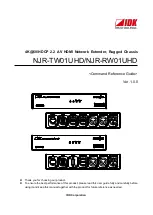
Planning the installation 8
HP rack products draw cool air in through the front and expel warm air through the rear of the enclosure.
Therefore, the front of the rack enclosure must be adequately ventilated to enable ambient room air to enter
the enclosure, and the rear of the enclosure must be adequately ventilated to enable the warm air to escape
from the enclosure.
IMPORTANT:
Do not block the ventilation openings.
If the front of the rack is not completely filled with components, the remaining gaps between the components
can cause changes in the airflow, which can adversely affect cooling within the rack. Cover these gaps with
blanking panels.
CAUTION:
Always use blanking panels to fill empty vertical spaces in the rack. This arrangement
ensures proper airflow. Using a rack without blanking panels results in improper cooling that can
lead to thermal damage.
Racks provide proper server cooling from flow-through perforations in the front and rear doors that provide
a 65% open area for ventilation.
Temperature requirements
To ensure continued safe and reliable equipment operation, install or position the rack in a well-ventilated,
climate-controlled environment.
The operating temperature inside the rack is always higher than the room temperature and is dependent on
the configuration of equipment in the rack. Check the TMRA for each piece of equipment before installation.
CAUTION:
To reduce the risk of damage to the equipment when installing third-party options:
•
Do not permit optional equipment to impede airflow around the chassis or to increase the
internal rack temperature beyond the maximum allowable limits.
•
Do not exceed the manufacturer’s TMRA.
Grounding requirements
This equipment must be grounded properly for proper operation and safety. In the United States, you must
install the equipment in accordance with NFPA 70, 1999 Edition (National Electric Code), Article 250, as
well as any local and regional building codes.
In Canada, you must install the equipment in accordance with Canadian Standards Association, CSA
C22.1, Canadian Electrical Code.
In all other countries, you must install the equipment in accordance with any regional or national electrical
wiring codes, such as the International Electrotechnical Commission (IEC) Code 364, parts 1 through 7.
Furthermore, you must be sure that all power distribution devices used in the installation, such as branch
wiring and receptacles, are listed or certified grounding-type devices.
Because of the high ground-leakage currents associated with this equipment, HP recommends the use of a
PDU that is either permanently wired to the building’s branch circuit or includes a nondetachable cord that
is wired to an industrial-style plug. NEMA locking-style plugs or those complying with IEC 60309 are
considered suitable for this purpose. Using common power outlet strips to supply power to this equipment is
not recommended.
Summary of Contents for Moonshot 1500
Page 57: ...Support and other resources 57 ...









































